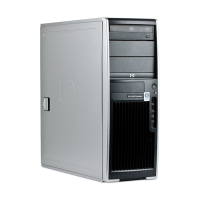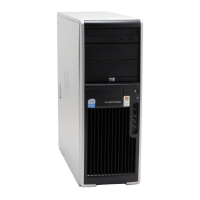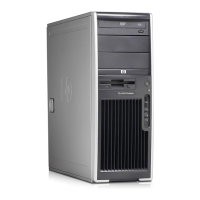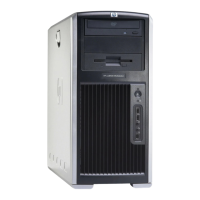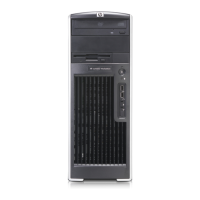TROUBLESHOOTING SCENARIOS AND SOLUTIONS 133
Chapter 5
Power LED flashes Red six times,
once every second, followed by a
two-second pause, and the
workstation beeps six times.
Pre-video graphics error. For systems with a graphics card:
1 Reseat the graphics card.
2 Replace the graphics card.
3 Replace the system board.
4 For systems with integrated graphics,
replace the system board.
Monitor does not function properly
when used with energy saver
features.
Monitor without energy saver
capabilities is being used with
energy saver features enabled.
Disable monitor energy saver feature.
Dim characters. The brightness and contrast
controls are not set properly.
Adjust the monitor brightness and contrast
controls.
Cables are not properly
connected.
Check that the graphics cable is securely
connected to the graphics card and the monitor.
Blurry video or requested
resolution cannot be set.
If the graphics controller was
upgraded, the correct video
drivers might not be loaded.
Install the video drivers included in the upgrade
kit.
Monitor is not capable of
displaying requested
resolution.
Change requested resolution.
The picture is broken up, rolls,
jitters, or flashes.
The monitor connections might
be incomplete or the monitor
might be incorrectly adjusted.
1 Be sure the monitor cable is securely
connected to the workstation.
2 In a two-monitor system or if another monitor
is in close proximity, be sure the monitors
are not interfering with each other’s
electromagnetic field by moving them apart.
3 Fluorescent lights or fans might be too close
to the monitor.
Monitor must be degaussed. Degauss the monitor.
Vibrating or rattling noise coming
from inside a CRT monitor when
powered on.
Monitor degaussing coil has
been activated.
None. It is normal for the degaussing coil to be
activated when the monitor is powered on.
Clicking noise coming from inside a
CRT monitor.
Electronic relays have been
activated inside the monitor.
None. It is normal for some monitors to make a
clicking noise when turned on and off, when
going in and out of standby mode, and when
changing resolutions.
High pitched noise coming from
inside a flat panel monitor.
Brightness and/or contrast
settings are too high.
Lower brightness and/or contrast settings.
Fuzzy focus; streaking, ghosting,
or shadowing effects; horizontal
scrolling lines; faint vertical bars; or
unable to center the picture on the
screen. (Flat panel monitors using
an analog VGA input connection
only.)
Flat panel monitor’s internal
digital conversion circuits
might be unable to correctly
interpret the output
synchronization of the graphics
card.
1 Select the monitor’s Auto-Adjustment option
in the monitor’s on-screen display menu.
2 Manually synchronize the Clock and Clock
Phase on-screen display functions.
Download SoftPaq SP20930 or SP22333,
depending on the monitor, to assist with the
synchronization.
Table 5-7 Solving Display Problems (Continued)
Problem Cause Solution

